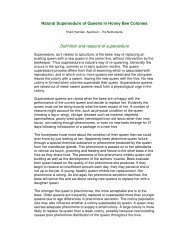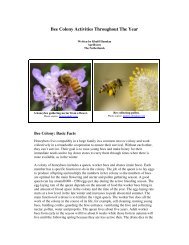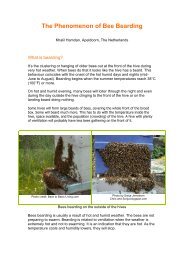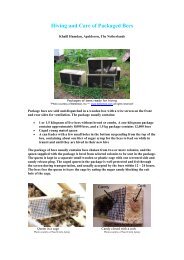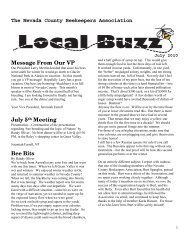Swarm Prevention By Demaree Method - Country Rubes
Swarm Prevention By Demaree Method - Country Rubes
Swarm Prevention By Demaree Method - Country Rubes
Create successful ePaper yourself
Turn your PDF publications into a flip-book with our unique Google optimized e-Paper software.
<strong>Swarm</strong>ing normally occurs in strong populous colonies, and mostly occurs in<br />
spring and early summer when weather conditions are favourable and flowers<br />
in bloom. A colony may issue several swarms leaving the hive nearly empty.<br />
<strong>Swarm</strong>ing is a problem in beekeeping. It weakens the colony and greatly<br />
reduces its honey production as the swarming occurs prior or during the main<br />
nectar flow season. Colonies that swarm do not provide a good working<br />
population for pollination of a crop.<br />
Although swarming is associated with reproduction, it can be triggered by<br />
other factors, most commonly by the following:<br />
. Overcrowding or congestion within the brood nest<br />
. The presence of an ageing queen<br />
. Insufficient space for the queen to continue laying eggs and for the worker<br />
bees to store the nectar and pollen they are bringing in to the hive<br />
. Some races of honeybees (Carniolan) are more prone to swarming than<br />
others (Italian).<br />
<strong>Swarm</strong>ing should be avoided because it severely reduces colony strength.<br />
The beekeeper should inspect his hives during the swarming season every<br />
ten to fourteen days and take measures to prevent his bees from swarming.<br />
A neglectful beekeeper may have hives that swarm often. There are several<br />
methods of preventing swarming i.e. dividing the colonies or keeping young<br />
queen or preventing overcrowding.<br />
One of the best ways to prevent a bee colony from swarming is by the way of<br />
the <strong>Demaree</strong> method. The method was devised by George <strong>Demaree</strong> and was<br />
first explained in an article in the American Bee Journal in 1884. In 1892 he<br />
again explained an improvement in his method. The objective is to separate<br />
the unsealed brood and eggs from the queen. Brood goes above an excluder,<br />
while the queen is below. This measure reduces overcrowding in the hive and<br />
therefore the bees desire to swarm; and makes it possible to retain the total<br />
colony population; and to keep honey production at a maximum. The<br />
technique has the advantage of allowing a new queen to be raised as well.<br />
It is important that <strong>Demaree</strong>’s method be applied at the correct time. The<br />
times will vary depending on the season and rate of building up and nectar<br />
source in the area (March in warmer climate, May in cooler climate).<br />
<strong>Demaree</strong> method, is carried out as follows:<br />
Step 1<br />
Remove the hive from its floorboard and put a new box with 8 drawn frames<br />
on its place.<br />
Step 2<br />
Go through the original brood box and locate the queen. Place her with two<br />
frames of sealed brood in the centre of the new box.



